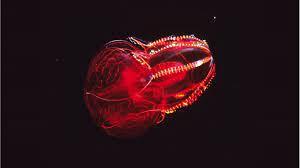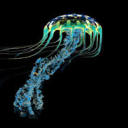Helmet Jelly


Helmet Jelly
Periphylla periphylla
The Helmet Jelly can be found at all depths of the ocean. This vibrant and strange jellyfish tends to proliferate in Norwegian fjords. They are one of the dominant predators in these isolated ecosystems.
Photos
http://www.seawater.no/fauna/cnidaria/periphylla.html
https://www.bigfishexpeditions.com/2019/01/24/norway-deepwater-shark-diving-2018/helmet-jelly/
More Posts from Bioluminescentoceangoddess and Others


Pacific Viperfish
Chauliodus macouni
The Pacific Viperfish looks intimidating with its sharp, pointy teeth and large jaws. However, its body is small and elongated. It can be found at depths ranging from 250m to 4390m. The Pacific Viperfish long teeth are an unique adaptation designed to keep prey trapped, but it is dangerously close to its eyes. There have been instances when they have caught prey that are too large to swallow and it dies along with its last meal. The Pacific Viper also has photophores along its body and a light organ near its dorsal fin. These organs exhibit bioluminescence and help with attracting pray: as well as, communicating with mates and confuse predators. It is one of the most ferocious predators of the deep ocean.
Photo credit: https://www.science-rumors.com/top-20-pacific-viperfish-facts-to-know-what-this-creature-is/
https://goldfisho.com/everything-you-need-to-know-about-viperfish/


Cockatoo Squid
Galiteuthis phyllura
The Cockatoo squid is a highly-specialized oddity of the deep ocean and found at depths between 300 to 1400 m. It is completely transparent, except for its eyes. It also has bioluminescent photophores that are directed downward: this makes it difficult for deep sea predators to see the Cockatoo Squid. It was named after the Cockatoo because it holds its tentacles above its head, resembling the bird. The Cockatoo squid can also get fairly large with adults reaching lengths of 2.7 meters (over 6 ft.)
Photocredit: https://www.americanscientist.org/article/at-home-in-the-dark
https://www.pinterest.com/pin/28710516347382519/

Marrus orthocanna
Marrus orthocanna is a deep sea siphonophore found at depths between 400m to 2200m. It has a colony of gas-filled zooids on the top used for locomotion. It also has a long, bright orange tentacles on the bottom. Marrus orthocanna are viscous predators and consume small crustceans and copepods.
Photo credit: http://www.arcodiv.org/watercolumn/cnidarian/Marrus_orthocanna.html
Sea sparkle is a common, bioluminescent plankton. Even though its not an animal, it is worth sharing.


Sea sparkle
Noctiluca scintillans
Sea sparkle is a bioluminescent dinoflagellate that blooms in many coastal waters. Sea sparkle feeds on plankton, diatoms, fish eggs, and other dinoflagellates. It also has a flagellum, or tiny tail, that helps it move around in the water. Even though sea sparkle is beautiful to witness at night, it is hazardous to other marine species and resembles a reddish-pink film during the day.
Photo credit:
https://alexandrathemb.tumblr.com/post/49814932878/noctilucas-scintillans-a-bioluminescent
https://thevelv.blogspot.com/2015/07/noctiluca-scintillans.html

Periphyllopsis braueri
The Periphyllopsis braueri is a tiny, deep sea jellyfish that is only 6 cm in diameter. It is red-chocolate in color, and it has eight gonads. Furthermore, it is found at depths between 600m to 1000m.
Photo credit: https://oceanexplorer.noaa.gov/explorations/19gulfofalaska/logs/aug2/aug2.html


Silky Medusa
Colobonema sericeum
The Silky Medusa is a gentle and reserved jellyfish; it has white-tipped tentacles that have the ability to detach from its body and bioluminescence when attacked by predators. It can be found drifting between 500 m to 1500 m. Furthermore, it consumes small crustaceans.
Photo credit: https://twitter.com/mbari_news/status/949736123760340994
https://www.montereybayaquarium.org/animals/animals-a-to-z/midwater-jelly

Hula Skirt Siphonophore
Physophora hydrostatica
The Hula Skirt Siphonophore a deep sea siphonophore that is found between 700 m to 1000m. It is made of a colony of hundreds tiny zooids. The top portion of the colony holds the swimming bells, which allow the colony to move. The bottom of the siphonophore holds the orange ‘hula skirt,’ which is full of stinging tentacles.
Photo link : https://twitter.com/montereyaq/status/1162068535331311617?lang=da

Vampire Squid
Vampyroteuthis infernalis
Even though the Vampire Squid is named after a notorious monster, this gentle creature does not live up to its name. It is only a foot long and occupies depths between 650m to 1500m in the deep ocean. Unlike other squids, it has reduced musculature and collects particles in the water column. However, it is capable of huge bursts of speeds. It uses bioluminescence to confuse both predators.
Photo credit: https://ocean.si.edu/ocean-life/invertebrates/vampire-squid-hell

Predatory Copepod
Paraeuchaeta barbata
Copepods are a type of zooplankton or tiny creature that feeds larger animals in the ocean such as, fish. They are crustaceans that have two long antennas and a sensory eye called an ocelli, which can only sense light. This copepod is located between 200m to 1500 m in the deep ocean. You may notice the copepod is red in color. The color is an adaptation that makes it difficult for predators to see the copepod because red wave lengths do not penetrate this depth (mostly blue and indigo light). Even though this creature tiny, it is a vital food source for many animals in the abyssal zone of the ocean.
Photo credit: http://www.arcodiv.org/watercolumn/copepod/Paraeuchaeta_barbata_large.html
An amazing glowing ctenophore!


Bloody-belly comb jelly
Lampocteis cruentiventer
The Bloody-belly is a 16 cm ctenophore that is found at depths 700 m to 1200m. It is crimson red in color and appears black in the deep ocean. However, the jelly has the ability to emit a different color. Furthermore, it uses highly iridescent ctenes to propel through the water.
Photo credit: https://laughingsquid.com/bloody-belly-comb-jelly/
https://www.reddit.com/r/deepseacreatures/comments/2j1717/bloodbelly_comb_jelly_lampocteis_cruentiventer/
-
 purenenaas reblogged this · 5 months ago
purenenaas reblogged this · 5 months ago -
 lichengender liked this · 8 months ago
lichengender liked this · 8 months ago -
 faultyconnection-error2981046 liked this · 8 months ago
faultyconnection-error2981046 liked this · 8 months ago -
 disaster-aroace liked this · 1 year ago
disaster-aroace liked this · 1 year ago -
 illshowyouascension liked this · 1 year ago
illshowyouascension liked this · 1 year ago -
 moths-in-a-sweater liked this · 1 year ago
moths-in-a-sweater liked this · 1 year ago -
 nightingaleinberkleysquare liked this · 1 year ago
nightingaleinberkleysquare liked this · 1 year ago -
 mycellpics liked this · 1 year ago
mycellpics liked this · 1 year ago -
 alienworlds reblogged this · 1 year ago
alienworlds reblogged this · 1 year ago -
 doyouknowmypoetry reblogged this · 1 year ago
doyouknowmypoetry reblogged this · 1 year ago -
 doyouknowmypoetry liked this · 1 year ago
doyouknowmypoetry liked this · 1 year ago -
 sem-piterno liked this · 1 year ago
sem-piterno liked this · 1 year ago -
 phileditor liked this · 1 year ago
phileditor liked this · 1 year ago -
 absolutesciencefiction reblogged this · 1 year ago
absolutesciencefiction reblogged this · 1 year ago -
 androidsghost liked this · 1 year ago
androidsghost liked this · 1 year ago -
 zenidogsworld liked this · 1 year ago
zenidogsworld liked this · 1 year ago -
 hammer-head-shark liked this · 1 year ago
hammer-head-shark liked this · 1 year ago -
 stardustandmoonflowers liked this · 1 year ago
stardustandmoonflowers liked this · 1 year ago -
 lemon-lime-lauren reblogged this · 1 year ago
lemon-lime-lauren reblogged this · 1 year ago -
 dragoonmagic liked this · 1 year ago
dragoonmagic liked this · 1 year ago -
 bewrabawa reblogged this · 1 year ago
bewrabawa reblogged this · 1 year ago -
 bunnywitch0 liked this · 1 year ago
bunnywitch0 liked this · 1 year ago -
 s0uthp0le liked this · 2 years ago
s0uthp0le liked this · 2 years ago -
 astraxolotlgirl reblogged this · 2 years ago
astraxolotlgirl reblogged this · 2 years ago -
 astraxolotlgirl liked this · 2 years ago
astraxolotlgirl liked this · 2 years ago -
 h0rus liked this · 2 years ago
h0rus liked this · 2 years ago -
 rocks-and-ravens liked this · 2 years ago
rocks-and-ravens liked this · 2 years ago -
 kittycatbuffet reblogged this · 2 years ago
kittycatbuffet reblogged this · 2 years ago -
 albinopotoo liked this · 2 years ago
albinopotoo liked this · 2 years ago -
 hairlice reblogged this · 2 years ago
hairlice reblogged this · 2 years ago -
 hairlice liked this · 2 years ago
hairlice liked this · 2 years ago -
 chimugukuru reblogged this · 2 years ago
chimugukuru reblogged this · 2 years ago -
 deep-sea-scholar liked this · 2 years ago
deep-sea-scholar liked this · 2 years ago -
 red-red-spout reblogged this · 2 years ago
red-red-spout reblogged this · 2 years ago -
 goblincreature808 liked this · 2 years ago
goblincreature808 liked this · 2 years ago -
 leafy-soup liked this · 2 years ago
leafy-soup liked this · 2 years ago -
 coffee-crypt liked this · 2 years ago
coffee-crypt liked this · 2 years ago -
 for-the-love-of-artemis reblogged this · 2 years ago
for-the-love-of-artemis reblogged this · 2 years ago -
 stop-and-smell-the-roses117 liked this · 2 years ago
stop-and-smell-the-roses117 liked this · 2 years ago -
 teeth-eyes-and-animals liked this · 2 years ago
teeth-eyes-and-animals liked this · 2 years ago -
 seainitsmajesty reblogged this · 2 years ago
seainitsmajesty reblogged this · 2 years ago -
 aphrodite-gleams liked this · 2 years ago
aphrodite-gleams liked this · 2 years ago -
 saltmatchescandlewax reblogged this · 2 years ago
saltmatchescandlewax reblogged this · 2 years ago -
 unknowinglysenescent reblogged this · 2 years ago
unknowinglysenescent reblogged this · 2 years ago -
 unknowinglysenescent liked this · 2 years ago
unknowinglysenescent liked this · 2 years ago

Bioluminescence is a chemical reaction that produces light. Many deep sea animals use bioluminescence. This blog is dedicated to educating the public about the amazing creatures that thrive in the deep sea.
57 posts